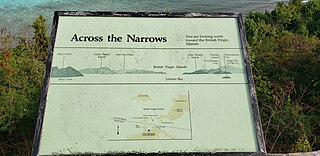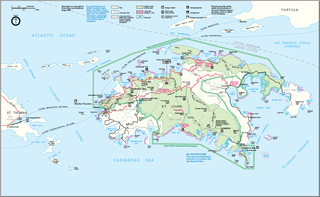
Geography of the United States Virgin Islands

Saint John is one of the Virgin Islands in the Caribbean Sea and a constituent district of the United States Virgin Islands (USVI), an unincorporated territory of the United States.

Cruz Bay, U.S. Virgin Islands is the main town on the island of Saint John in the United States Virgin Islands. According to the 2000 census, Cruz Bay had a population of 2,743.

The Virgin Islands Coral Reef National Monument is a U.S. National Monument located off Saint John, Virgin Islands.

Trunk Bay is a body of water and a beach on St. John in the United States Virgin Islands. Trunk Bay is part of the Virgin Islands National Park. Trunk Bay is named for the Leatherback turtle, which is endemic to the U.S.V.I. and is locally known as trunks. The beach area is divided into two halves, the main Trunk Bay beach and swim area and Burgesman Cove which is located on the west end of Trunk Bay near Jumby Bay. Its amenities include a snack bar, showers and restrooms, a lifeguard, and an underwater trail for snorkeling its coral reef. Trunk Bay has consistently been voted one of the top beaches in the world.
Waterlemon Cay is a small cay surrounded by a fringing reef located in Leinster Bay on Saint John, U.S. Virgin Islands. It is named after the water lemon.
Carolina is a neighborhood on the island of Saint John in the United States Virgin Islands. It is located in the hills to the west of Coral Bay.
Concordia is an area on the island of Saint John in the United States Virgin Islands. It is located on the south east corner of the island, near Salt Pond Bay. Much of the area is part of Virgin Islands National Park. Concordia Eco-Resort is located here.
Fish Bay is a bay and neighborhood on the island of Saint John in the United States Virgin Islands. Most of this area is part of Virgin Islands National Park.
Johns Folly is a neighborhood on the island of Saint John in the United States Virgin Islands. It is located on the east side of the island, south of Coral Bay and north of Salt Pond Bay.
Lameshur is a former plantation on the island of Saint John in the United States Virgin Islands. It is inside Virgin Islands National Park and home to the Virgin Islands Environmental Resource Station (VIERS). The Tektite program placed two underwater habitats in Great Lameshur Bay and the Tektite Underwater Habitat Museum is located in the VIERS camp. The road to Lameshur is unmaintained and 4 wheel drive vehicles are often required. The University of the Virgin Islands has a research station and dock in Lameshur on Yawzi Point.

Leinster Bay is a bay and former sugar cane plantation on the island of Saint John in the United States Virgin Islands. It is uninhabited and part of Virgin Islands National Park. Visitors can park at Annaberg and hike the Leinster Bay trail to access the bay, which is a popular snorkeling spot. Waterlemon Cay is a small cay in Leinster Bay. The ruins of the plantation's estate house can be reached by continuing past the bay and up the Johnny Horn Trail.
Mary Point is an uninhabited peninsula on the island of Saint John in the United States Virgin Islands. There are no roads or trails and steep cliffs prevent access from the water. Although Mary Point once housed a small sugar cane plantation, the area is now overgrown with thick forest. The foundation and crumbling walls of Mary Point Estate can be seen from the Francis Bay trail. It is part of Virgin Islands National Park. Mary Creek, the shallow bay on the east side, is a popular spot for fly fishing and kitesurfing.
Mount Pleasant is an area of Virgin Islands National Park on the island of Saint John in the United States Virgin Islands. It is located between Maho Bay and Centerline Road. This area is uninhabited and its name has fallen out of use.
Reef Bay is a neighborhood and bay on the island of Saint John in the United States Virgin Islands. Most of this area is part of Virgin Islands National Park. The inhabited portion is along the west side of Reef Bay, near Fish Bay. The Reef Bay Sugar Factory ruins are located in the center of Reef Bay, in an area known as Genti Bay. The nearly 3 mile long Reef Bay Trail is a National Park Service maintained hiking trail that runs through the area from Centerline Road to Genti Bay.
Sieben is a former plantation on the island of Saint John in the United States Virgin Islands. Homes in this area are considered by the local government to be located in Remainder Fish Bay. The Sieben plantation ruins are accessible via the L'Esperance Trail. Most of this area is part of Virgin Islands National Park. The only baobab tree on St. John is near the Sieben ruins.

Steven Cay is a small scrub-covered and rocky Caribbean island, about 28 feet high and situated 0.5 miles west of Cruz Bay on Saint John in the United States Virgin Islands. It is a popular destination for snorkelers and scuba divers, and its waters feature coral reefs and sea fans, mountain corals, star corals, large quantities of angel- and triggerfish, as well as lobsters, nurse sharks and pillar corals.

Trunk Cay is a small grass-covered islet in Trunk Bay in the United States Virgin Islands. It has an elevation of 48 feet and is situated only 200 feet from Trunk Bay Beach. It is an islet of rocky cliffs, coral sandy beaches, and palm trees. The Virgin Islands National Park Service offers underwater snorkeling trails around the cay. Trunk Cay is named for the Leatherback turtle, which is endemic to the U.S.V.I. and is locally known as trunks.

Leduck Island is an island in the United States Virgin Islands, also spelled LeDuck Island, which is located 0.5 miles east of Sabbat Point in Johns Folly, separated from Saint John by the Sabbat Channel. LeDuck Island lies by the entrance to Coral Bay and is 85 feet high. Leduck Island is located within the Virgin Islands National Park and is one of the largest offshore islands to Saint John, along with Grass Cay and Congo Cay. Being home to numerous spur and groove reefs, it is a popular scuba diving destinations and its reefs are habitat for an abundance for endemic tropical fish species. Some of the fish species found here include the Fairy basslet, Sergeant major, French angelfish, Gray angelfish, Queen triggerfish, Jackknife-fish, Blue chromis, Schoolmaster snapper, Mangrove snapper, Red hind, Blacktip shark, Hawksbill sea turtle, Glassy sweeper, Squirrelfish, and numerous species of damsels and jacks.










